What do Star Forts Look Like From Space? 20 Satellite Images That Will Take Your Breath Away
- Zuzana Hajkova, Content Marketing Coordinator, EUSI
Star forts, or bastion forts, came to life when cannons started dominating the battlefield. A need for thick walls with good viewing angles suddenly emerged, and military engineers started designing fortresses with polygonal walls, bastions in the corners, ravelins and moats. But star forts are not only hard to conquer; they are also beautiful. Let’s join us on a fascinating journey through architecture and history – from space. All satellite images in this article were collected by WorldView-3, WorldView-2 or GeoEye-1 at native resolution of 30–50 cm.
1. Citadel of Alessandria, Italy
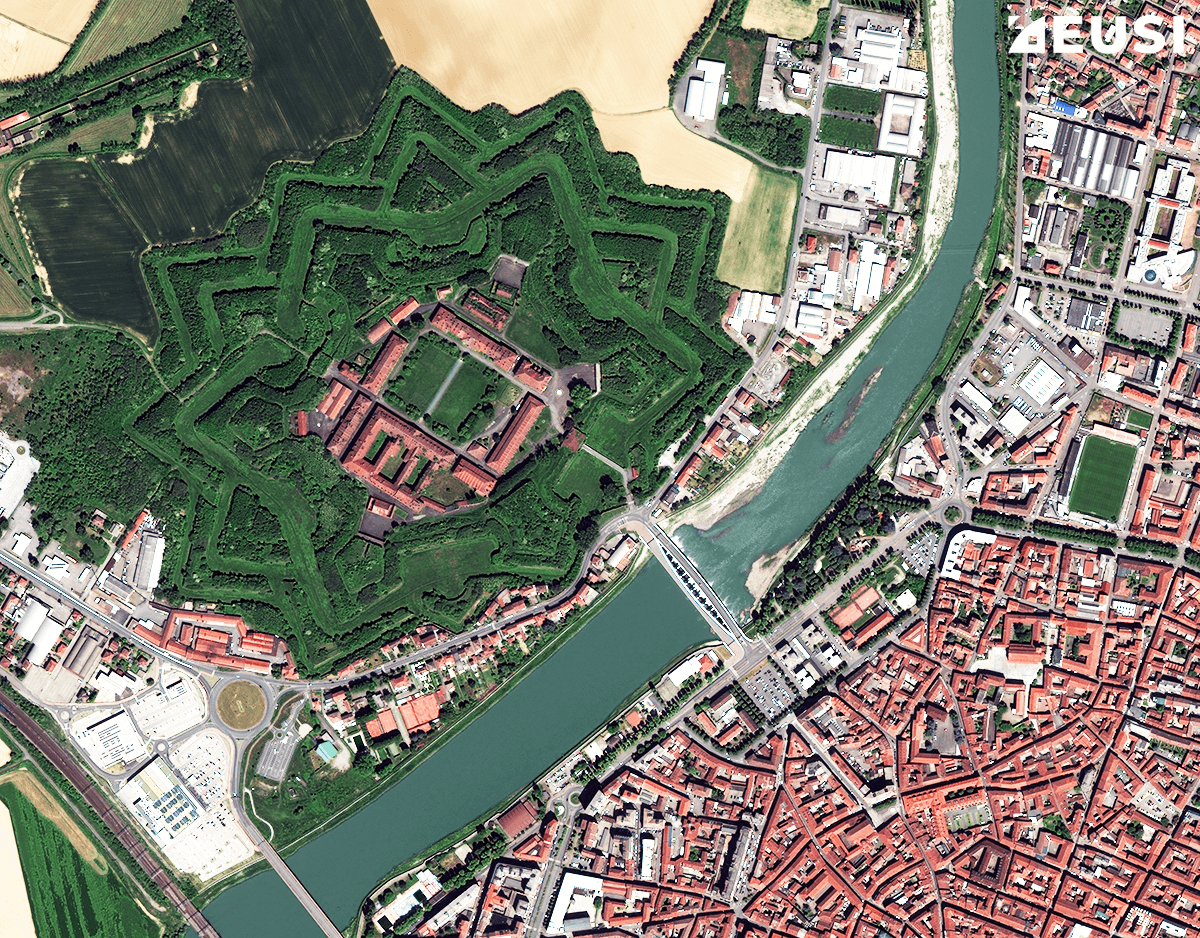
Collected on 2 May 2020 by WorldView-2 satellite at 40 cm resolution. Off-nadir angle: 3.6°. © Maxar Technologies Collected by EUSI
The Citadel of Alessandria lies across the river Tanaro northwest of the city of Alessandria. It extends over 20 hectares, which is the size of 28 football fields, and is surrounded by a wide moat connected to the river through flooding tunnels. The Citadel of Alessandria is inscribed on the UNESCO World Heritage List.
Alessandria was meant to be a border town. Therefore, the fortress needed to protect a long borderline; that’s why it was built in the shape of an elliptical hexagon. It was constructed after the Treaty of Utrecht in the early 18th century when the area became part of the new state of Savoy. It has witnessed many historic events: the War of the Austrian Succession, when the fort resisted the French-Spanish army for seven months, the First Italian Campaign which brought another siege, this time by the Austro-Russian army, European restoration, the proclamation of the Kingdom of Italy, and the World War II.
2. Fort Bourtange, the Netherlands
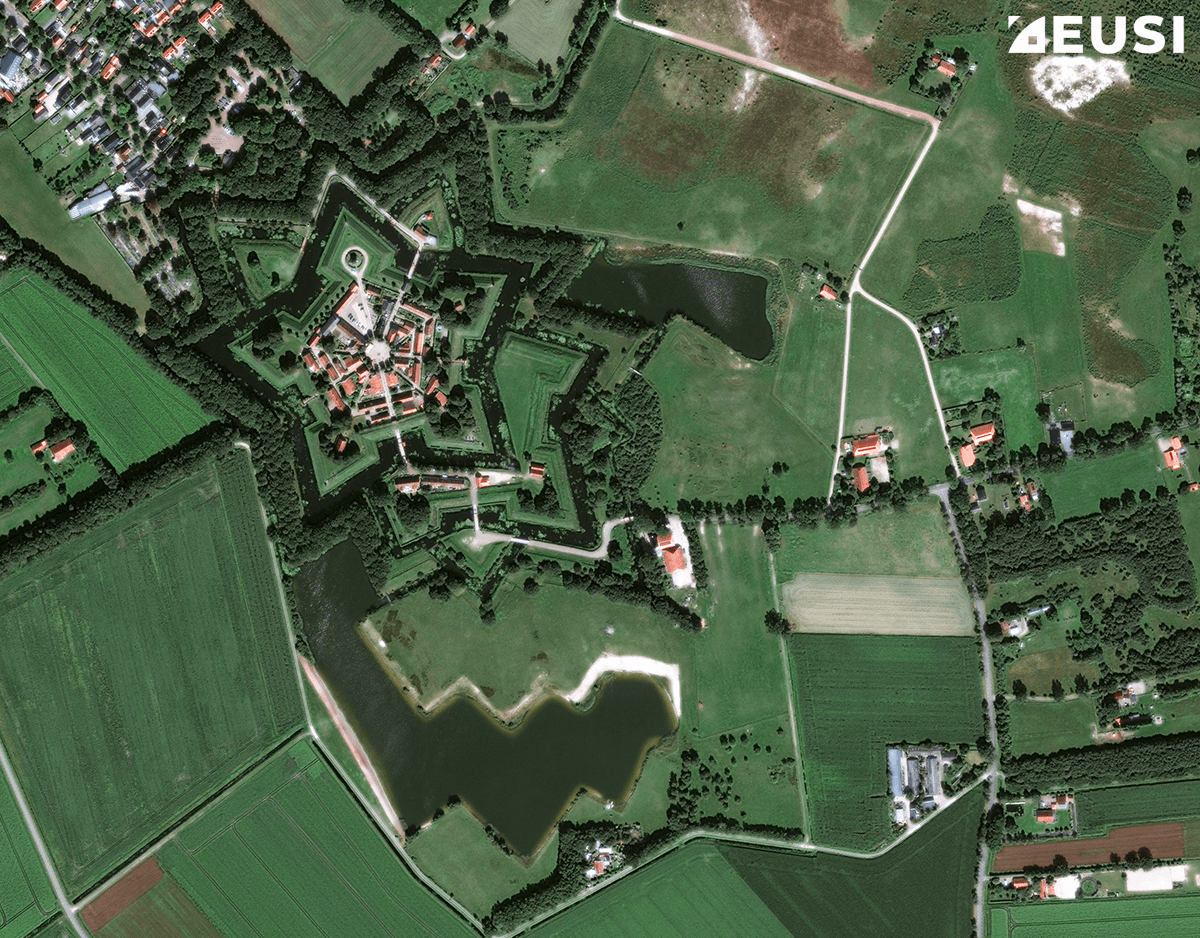
Collected on 11 August 2023 by GeoEye-1 satellite at 40 cm resolution. Off-nadir angle: 13.1°. © Maxar Technologies Collected by EUSI
Now transformed into a charming star-shaped village, Fort Bourtange was built in the 16th century during the Eighty Years‘ War. It had a strategic location near the German border, and was constructed to protect the only road between Germany and the city of Groningen which was under Spanish control.
The fort was strategically surrounded by a swamp. However, the swamp was dried up by agricultural practices, and Bourtange had to be transformed into a residential village. Nowadays, it is a beautiful, well-preserved touristic site with original houses, churches, bridges, cobblestone roads, and windmills.
3. Saint-Martin-de-Re, France
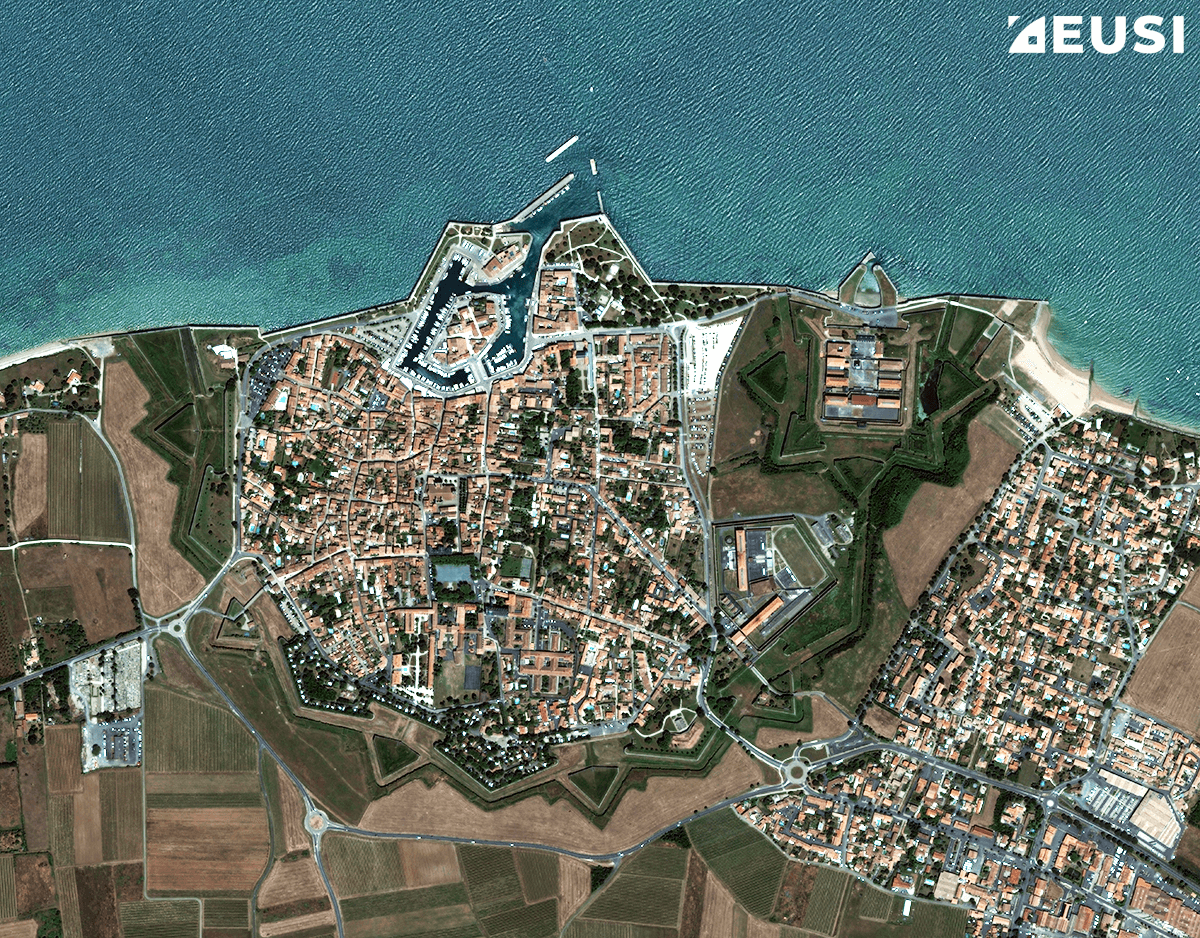
Collected on 10 June 2023 by WorldView-2 satellite at 40 cm resolution. Off-nadir angle: 4.9°. © Maxar Technologies Collected by EUSI
The fortification incorporates the town of Saint-Martin-de-Re within its walls, creating a fortified urban center. The lengths of the bastions vary, and their specific arrangement creates an irregularity in the star shape. This assymetry suggests that the positioning of the bastions was adapted to the natural features around the fort.
Ile de Re, the French island where the fort is situated, was fortified under the orders of Cardinal Richelieu during the Wars of Religion in the 1620s. The star-shaped fortification was constructed later, towards the end of the 17th century, as part of the effort to protect the French coast against potential invasions. Today, Saint-Martin-de-Re is a UNESCO World Heritage Site.
4. Vardohus, Norway
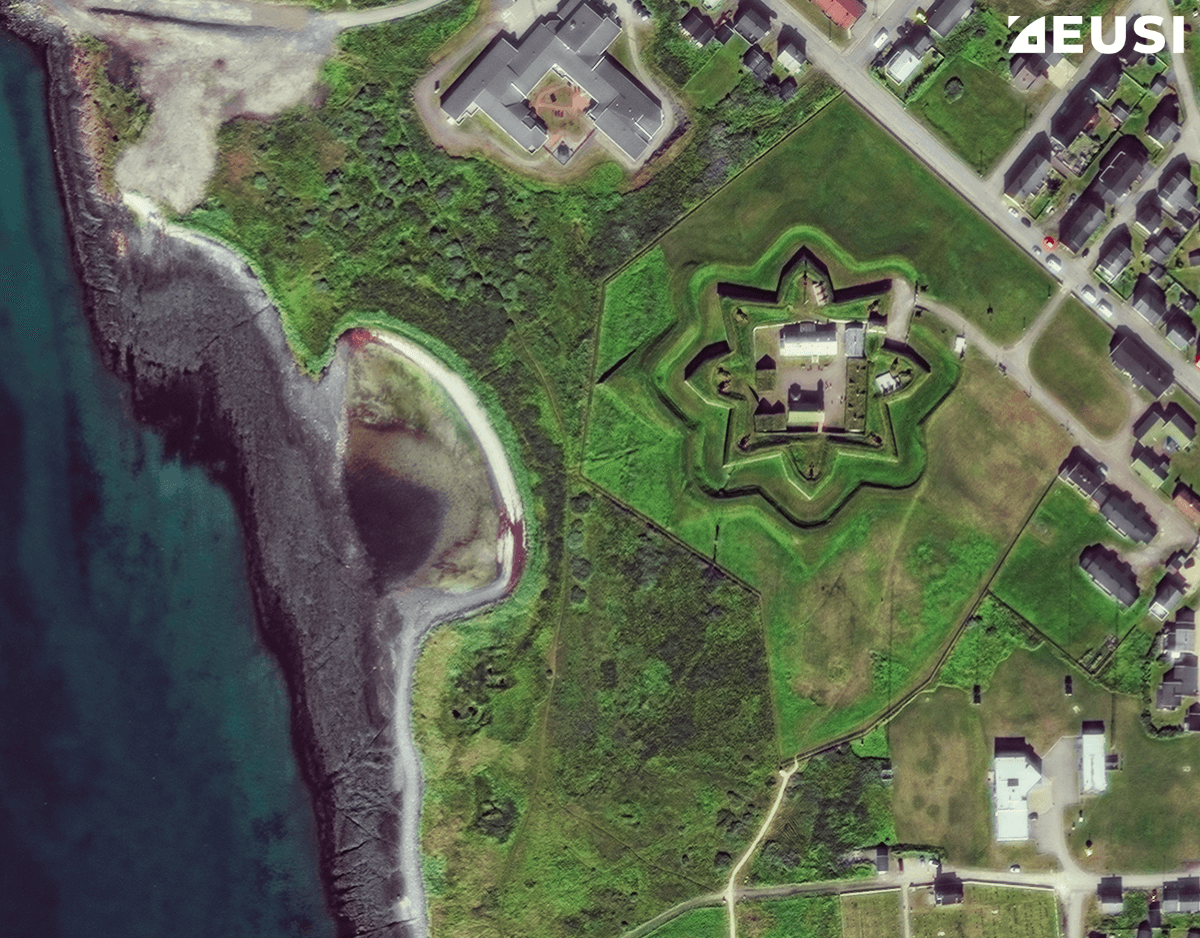
Collected on 7 August 2021 by GeoEye-1 satellite at 40 cm resolution. Off-nadir angle: 9.5°. © Maxar Technologies Collected by EUSI
Vardohus Fortress is known as the world’s northernmost fort. Its construction dates back to the early 18th century, during a period when tensions between neighbouring nations and the strategic importance of the Arctic region prompted the need for robust defensive structures. Built by Peter Jansen Wessel, a prominent Norwegian naval officer and military commander, the Vardohus Fortress played a vital role in securing Norway’s northern territories and protecting against potential external threats, particularly from Russia.
Vardohus is a small fort – in 1940, the only weapons available for the garrison were four field guns, three machine guns, and four cannons. Its sole action came in June 1940 when the fortress was attacked by a German bomber that missed its intended target, a radio station. In response, Vardohus hit the bomber with gunfire and wounded its navigator.
5. Almeida, Portugal
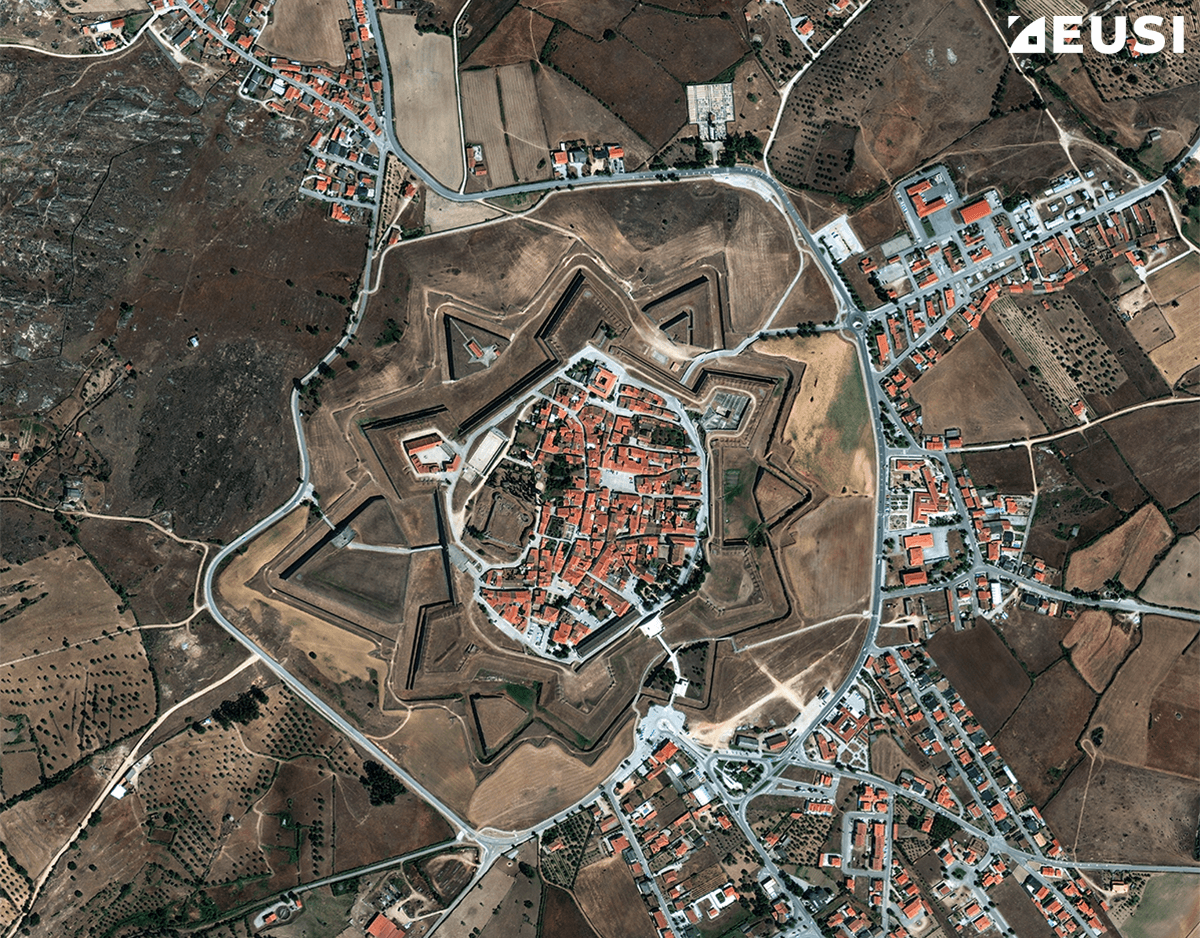
Collected on 4 August 2023 by WorldView-3 satellite at 30 cm resolution. Off-nadir angle: 29.0°. © Maxar Technologies Collected by EUSI
Almeida is a fortified town in Portugal, known for its unique twelve-pointed design. It consists of a complex system of masonry walls, ravelins, platforms, hidden passages, cannon embrasures, trenches, and a moat – all within a perimeter of 2,500 meters. Both entrances to the fortress are bomb-proof and only accessible through bridges. The fortification is built around a castle from the medieval times. Nowadays, only remnants of the castle are visible.
The fort is strategically located 12 kilometers from the border with Spain, to strengthen the Portuguese borders in the War of Restoration fought between Spain and Portugal. Later, part of the fortification was destroyed by a huge gunpowder explosion during a siege by Napoleon’s troops, which led to the fort‘s surrender. Nowadays, the Fortress of Almeida is a popular destination for tourists interested in military history.
6. Fort Csillag, Hungary + Komarno, Slovakia
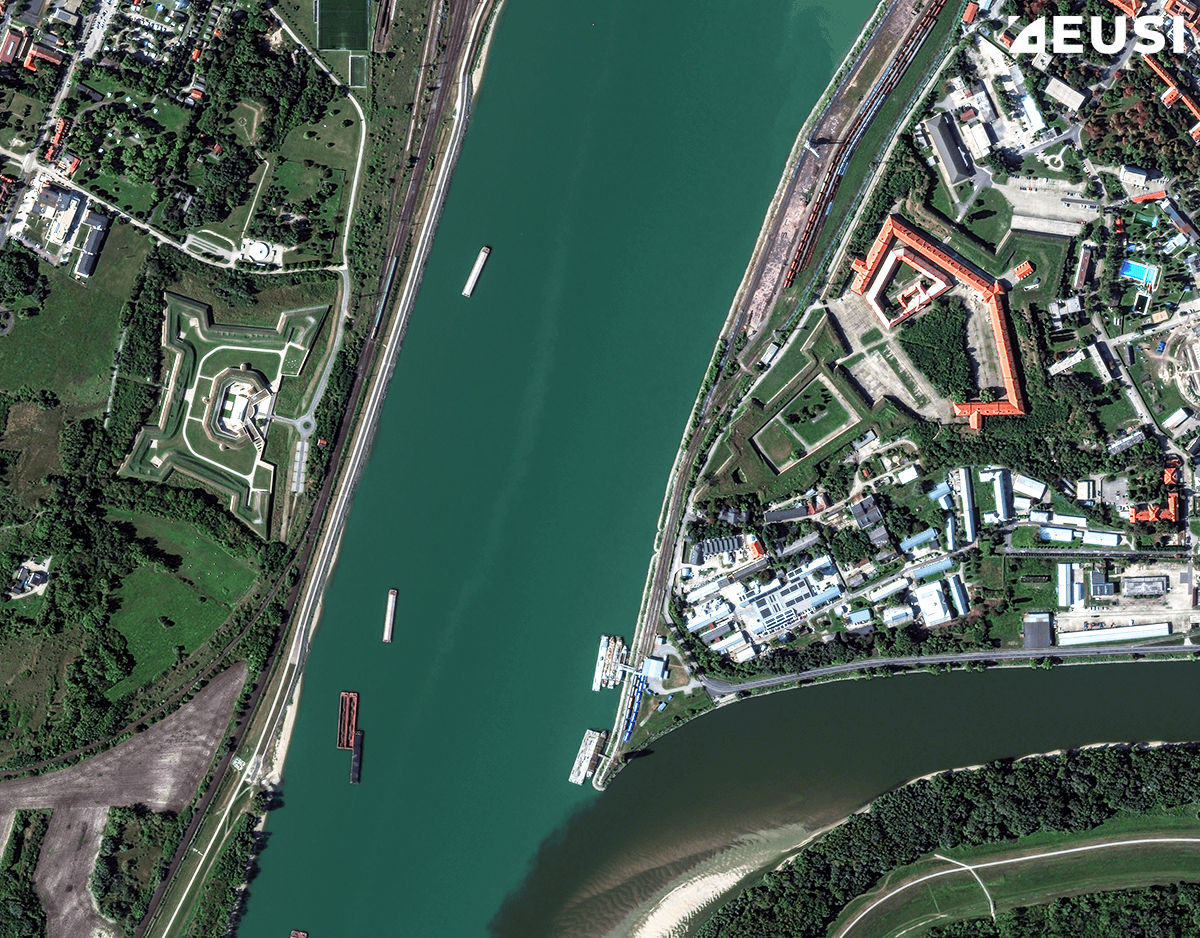
Collected on 29 September 2023 by WorldView-2 satellite at 50 cm resolution. Off-nadir angle: 15.1°. © Maxar Technologies Collected by EUSI
Two fortresses sit on opposite sides of the Danube River which forms a natural border between modern-day Hungary and Slovakia – Fortress Komarno on the Slovakian side (on the right in the image) and Fort Csillag on the Hungarian side (on the left in the image). However, when the forts were constructed, the whole area belonged to the Austro-Hungarian Empire. The purpose of both fortresses was to supervise ship traffic and defend the confluence of the Danube and Vah rivers.
The construction of the fort started in the mid-16th century. Unfortunately, it seems the architects were not familiar with the soil in the area, as the fort was flooded and most of the walls were destroyed. And that wasn’t the only disaster the fortress has witnessed. It encountered plague and two earthquakes with nearby epicenters in 1763 and 1783. The fort wasn’t renovated until the Napoleonic Wars, when it regained its strategic importance.
7. Neuf Brisach, France
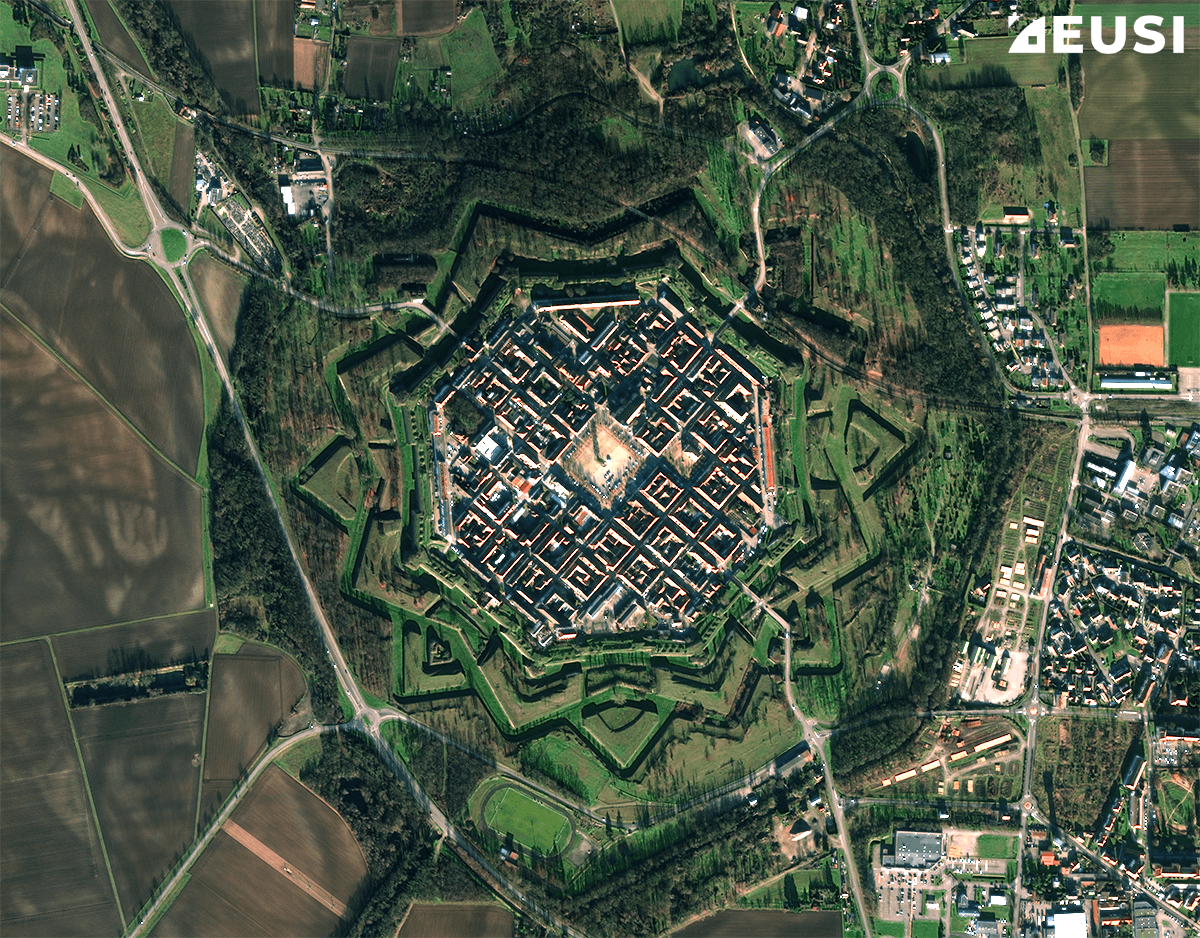
Collected on 3 January 2023 by WorldView-2 satellite at 50 cm resolution. Off-nadir angle: 26.5°. © Maxar Technologies Collected by EUSI
The fortified town of Neuf-Brisach was founded under the orders of the Sun King, Louis XIV. It consists of a central parade ground, buildings that form a perfect octagon, and a complex of walls and moats in the shape of a star. The curtain walls are strengthened by tenement blocks built inside them, shielding more expensive houses from cannon fire.
The city was designed by Vauban, a famous French military engineer, between 1699 and 1703 as a response to King Louis XIV losing the town of Brisach on the other side of the Rhine. It is considered Vauban‘s masterpiece, and listed as a UNESCO World Heritage Site as part of the “Fortifications of Vauban“ (together with 11 other fortified structures).
8. Leopoldov, Slovakia
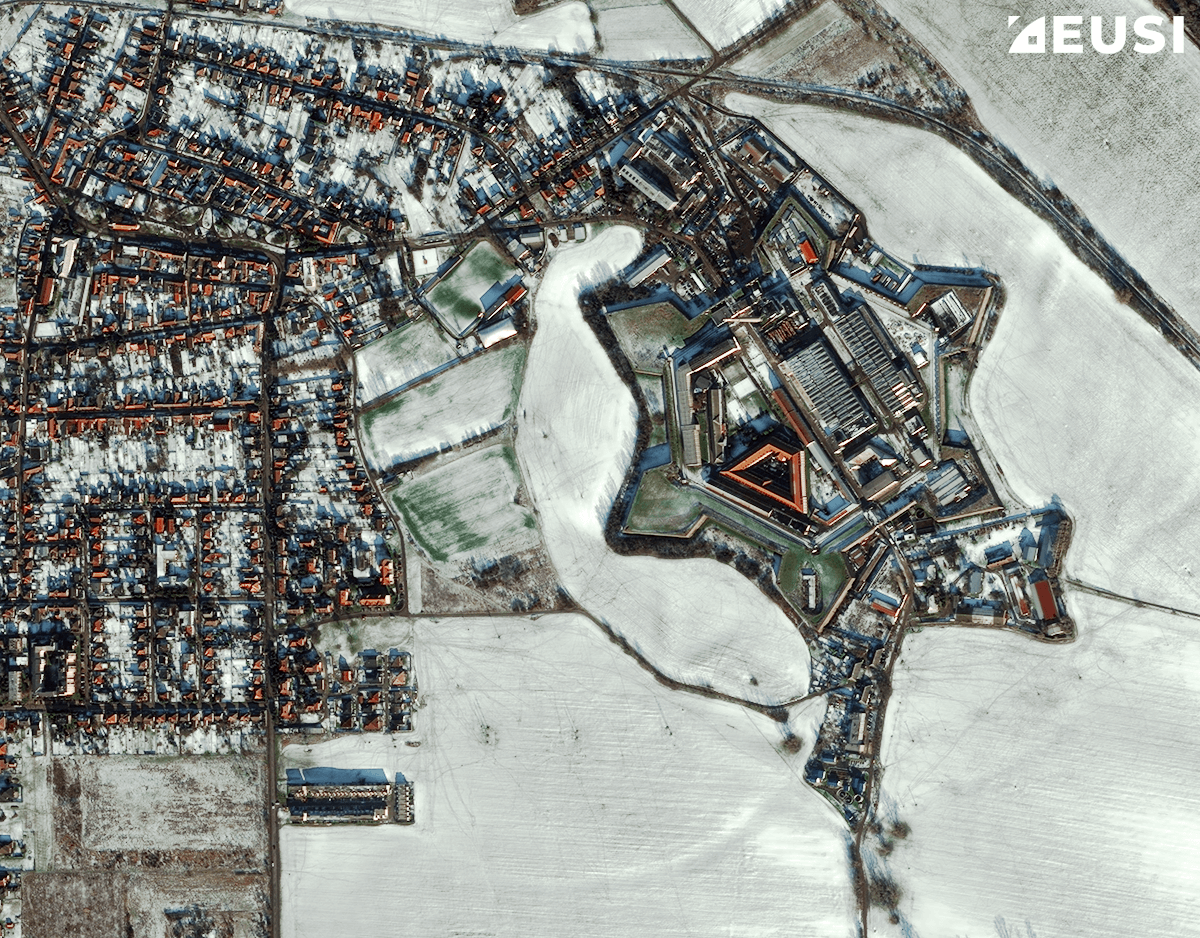
Collected on 21 January 2021 by GeoEye-1 satellite at 40 cm resolution. Off-nadir angle: 25.2°. © Maxar Technologies Collected by EUSI
Leopoldov, also called Leopoldstadt or Lipotvar, is unique for its radial design which is a departure from the traditional straight and angular bastions found in many other star forts. The curved layout provides a broader field of view and allows for more versatile positioning of cannons.
Leopoldov was constructed in the 1660s during the reign of Emperor Leopold I of the Habsburg Monarchy. It was part of a wider defensive strategy against Ottoman invasions and other external threats. However, the Turks never attacked the fort. Over time, Leopoldov evolved, and during the 18th century, it turned into a military warehouse and a prison. It was able to inhabit 1,000 prisoners, making it the largest prison in Austria-Hungary at the time. Today, Leopoldov remains in operation as a prison.
9. Kastellet, Denmark
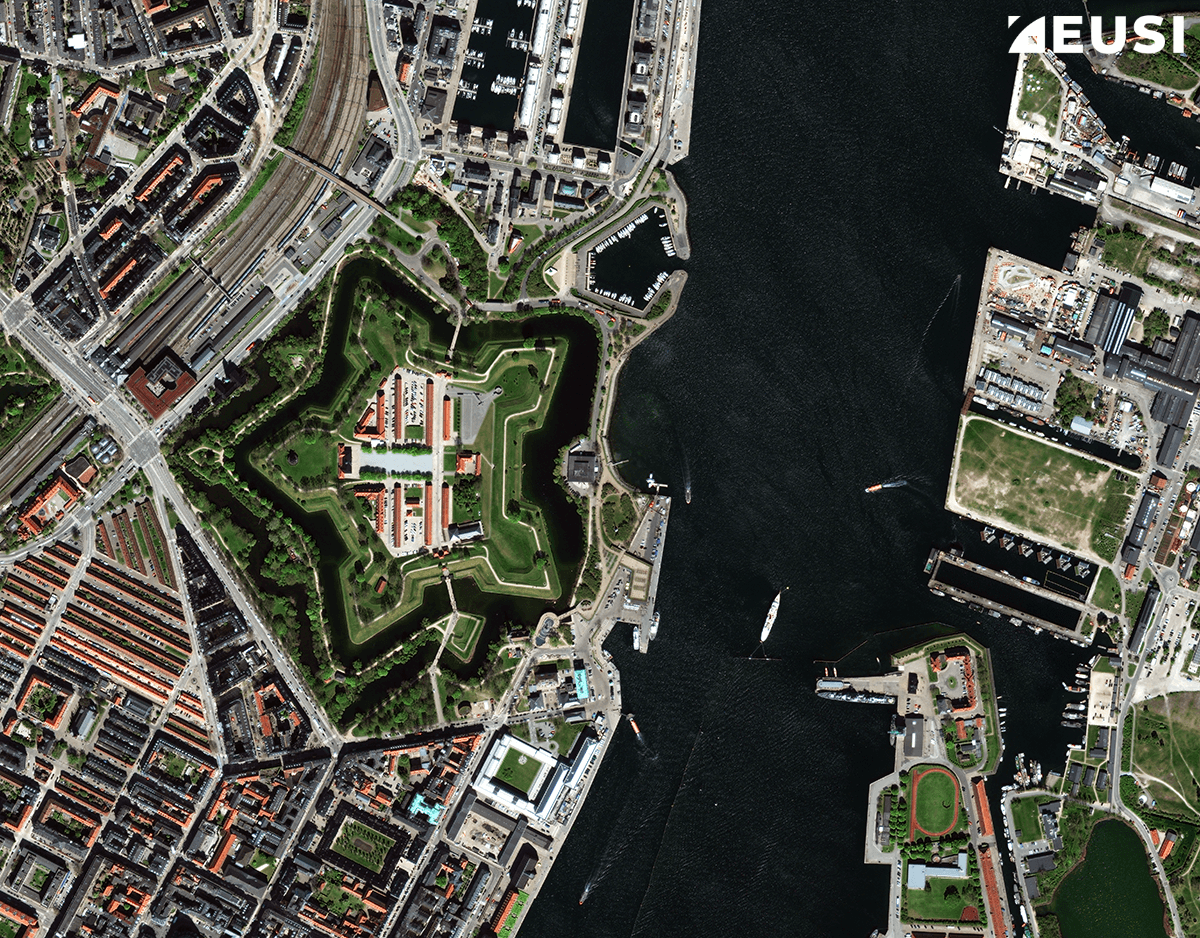
Collected on 8 May 2023 by WorldView-3 satellite at 30 cm resolution. Off-nadir angle: 11.6°. © Maxar Technologies Collected by EUSI
Kastellet, located in the heart of Copenhagen, includes five bastions surrounded by a system of moats and outworks. It can be approached by two bridges with gates, leading from the south and the north. The six long buildings you can see in the image were barracks; each room measured 16 m2 and contained two triple beds, two benches and a table. Kastellet also includes a windmill (in the western corner of the fortification) to secure supplies of flour in case of siege.
The construction of Kastellet started in 1626 to guard the entrance to the port, and was extended later, after the siege of Copenhagen by the Swedish. The first ever terror attack on a European capital happened here – in 1807, during the Napoleonic Wars, the British intentionally targeted a civilian area, without even declaring war on Denmark. This event is known as the Battle of Copenhagen. Another time the fort played a role in wartime was during World War II when Kastellet was captured by Germany in 1940. Nowadays, the site includes museums and hosts events, such as military concerts.
10. Kuressaare Castle, Estonia
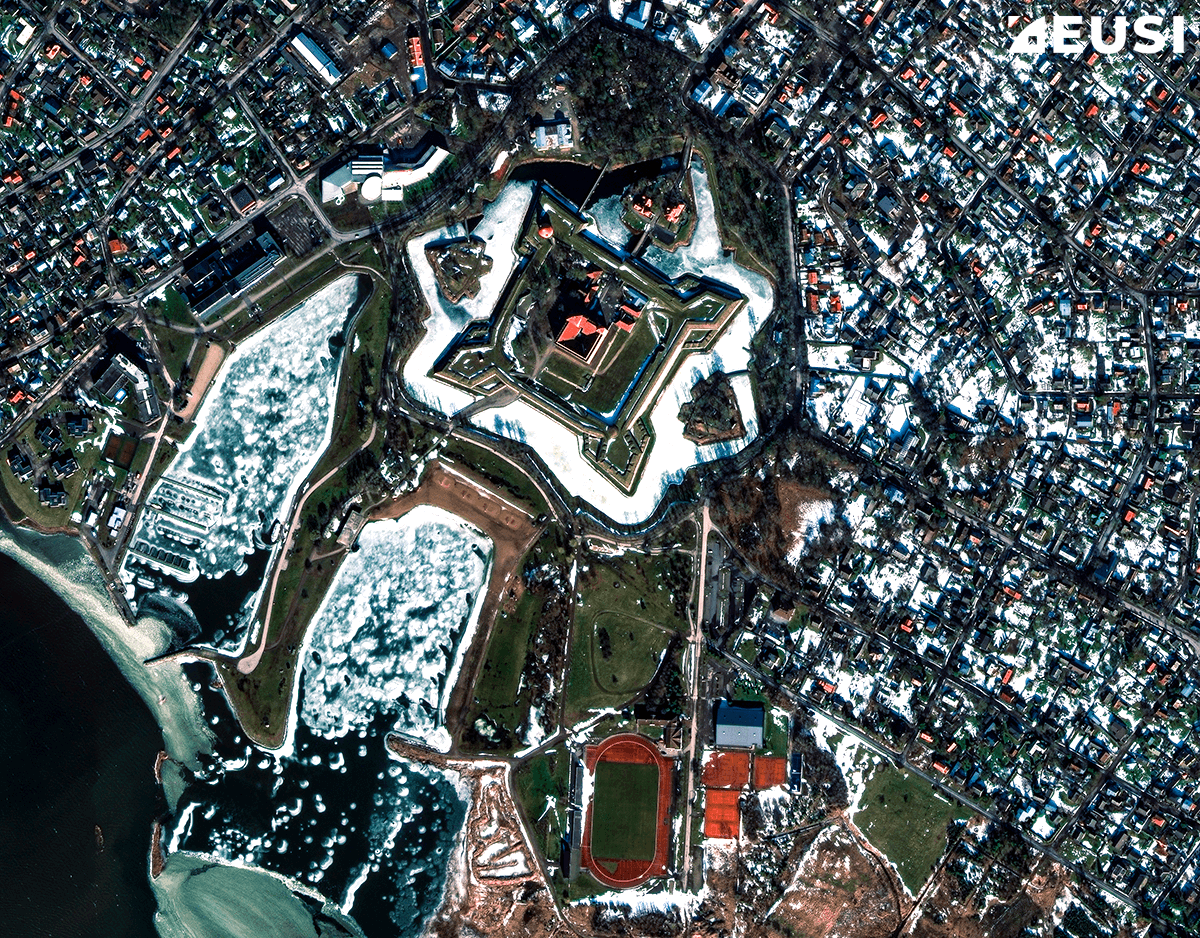
Collected on 14 March 2023 by GeoEye-1 satellite at 40 cm resolution. Off-nadir angle: 13.5°. © Maxar Technologies Collected by EUSI
The first written record of Kuressaare Castle, situated on Saaremaa Island, comes from the late 14th century. It served as a military stronghold until the early 18th century, however, the borders of the Russian Empire gradually moved further west and Kuressaare lost its strategic value. The garrison completely withdrew in 1836, and the fort was used for different purposes.
As a result, Kuressaare Castle has served multiple functions throughout its existence. It has been a bishop’s residence, a nobleman’s stronghold, and even a courthouse. Kuressaare includes a prominent residential wing, the castle courtyard is used for various cultural and communal activities, and the main keep, which is a prominent structure of the fort, often housed the lord’s residence and administrative chambers, and sometimes served as a last line of defense.
11. Terezin, Czechia
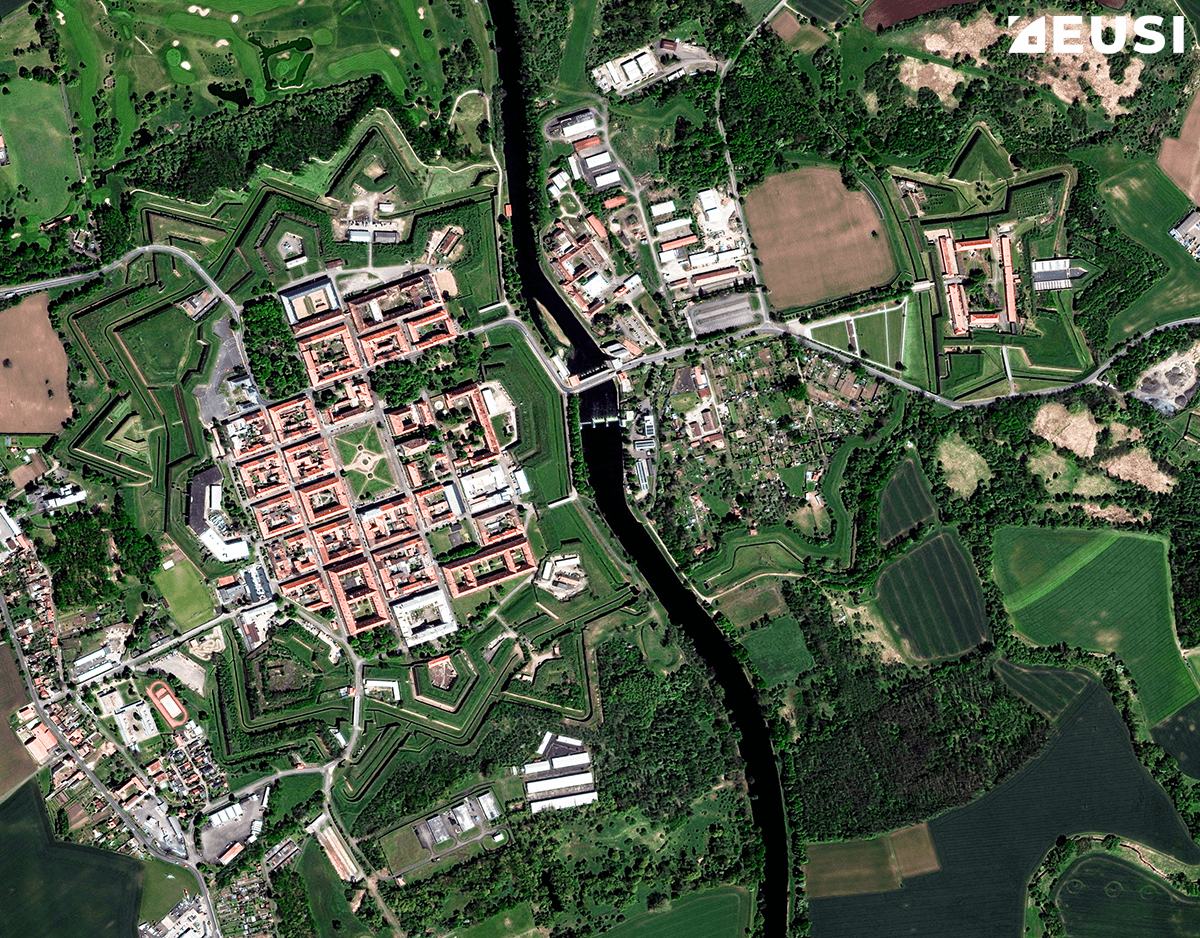
Collected on 11 May 2021 by WorldView-2 satellite at 50 cm resolution. Off-nadir angle: 29.9°. © Maxar Technologies Collected by EUSI
Terezin is a large military complex with a perimeter of over 20 kilometers, constructed by the Habsburgs in the late 18th century to secure the confluence of the Elbe and Eger rivers against the Prussian troops invading from modern-day Germany. It is divided into three parts:
- Main Fortress (west of the river)
- Small Fortress (east of the river)
- the brick entrenchment between them
Each of the parts has a different level of fortification; as the Prussian attack was expected to come from the west, the Main Fortress is the most fortified one. It is built as an octagon, with bastions in its vertices connected by curtain walls. The only way to enter the fort was through secured gates and posterns.
Terezin, initially built as a fortress, later served as a ghetto and deportation base during World War II. Even though Terezin wasn‘t an extermination camp, approximately 35,000 prisoners lost their lives to overcrowding, malnutrition and disease. The Small Fortress (part of the fortification across the river, in the top right part of the image) was used as a Gestapo prison. Nowadays, Terezin is a frequently visited memorial site, with 90% of the original material intact.
12. Charles Fort, Ireland
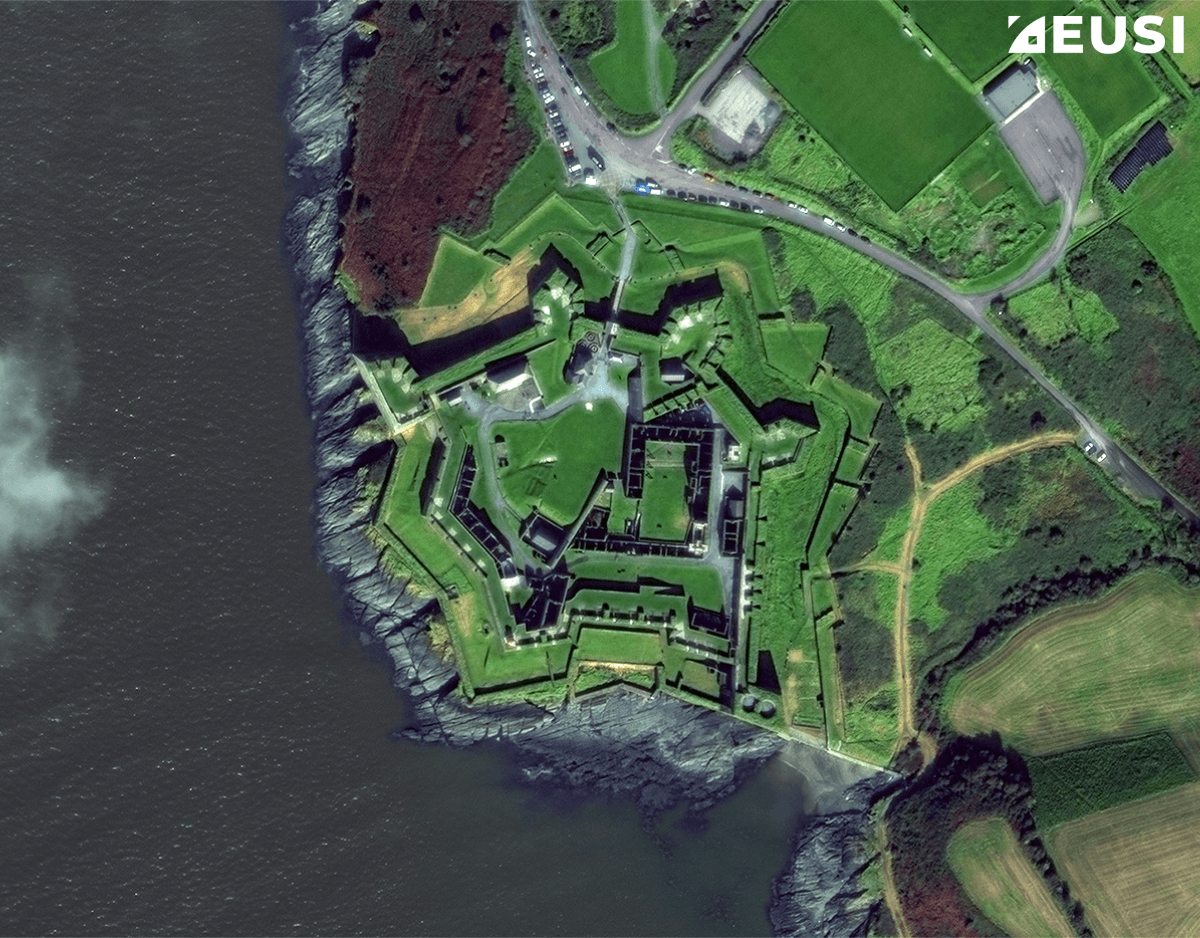
Collected on 1 October 2023 by GeoEye-1 satellite at 40 cm resolution. Off-nadir angle: 20.5°. © Maxar Technologies Collected by EUSI
Charles Fort, perched on the shores of Kinsale Harbour, leaves visitors impressed: parts of the fortification are 16 meters high. It is a pentagonally bastioned fort, with the two seaward bastions being the strongest – it was expected that attacks would come from the sea. The remaining bastions, positioned towards the land, are overlooked by higher ground, which turned out to be a weakness when the fort was sieged and captured by the Williamites in 1690.
Built during the reign of Charles II to protect the harbour, the fort has played a vital role in safeguarding Ireland’s southern coastline since the 17th century. It was used by the British Army for two hundred years, and decommissioned after being burned during the Irish Civil War in 1922.
13. Palmanova, Italy
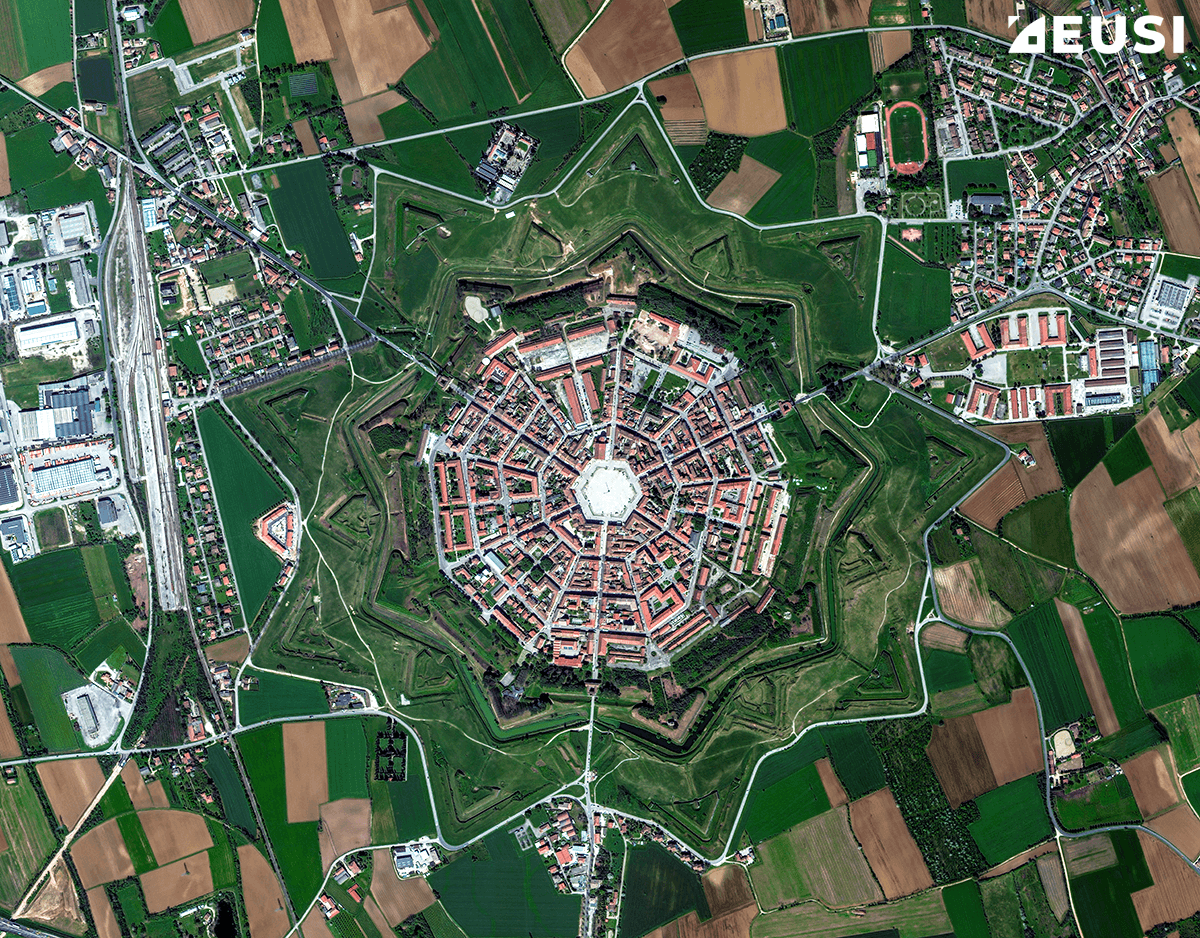
Collected on 14 April 2018 by WorldView-3 satellite at 30 cm resolution. Off-nadir angle: 23.6°. © Maxar Technologies Collected by EUSI
Palmanova is a fortified town of the late Renaissance, built by the Venetian Republic at the end of the 16th century. It consists of three nine-sided ring roads, following the ideas expressed in Utopia by Thomas More. The book says a city should be geometric in shape and surrounded by a wall, to not only provide military strength but also to enhance the spreading of skill and knowledge among the people living inside the walls.
However, even though a symmetrical town was considered perfect, the location of Palmanova meant nobody wanted to live there. It was situated precariously close to the border with modern-day Slovenia, to stop the Ottomans from advancing farther into the Venetian Republic. To solve the problem, Venetia had to pardon prisoners and give them property in Palmanova. In the end, the Turks didn’t attack, and the fortification was completed under Napoleonic domination.
14. Fort Manoel, Malta
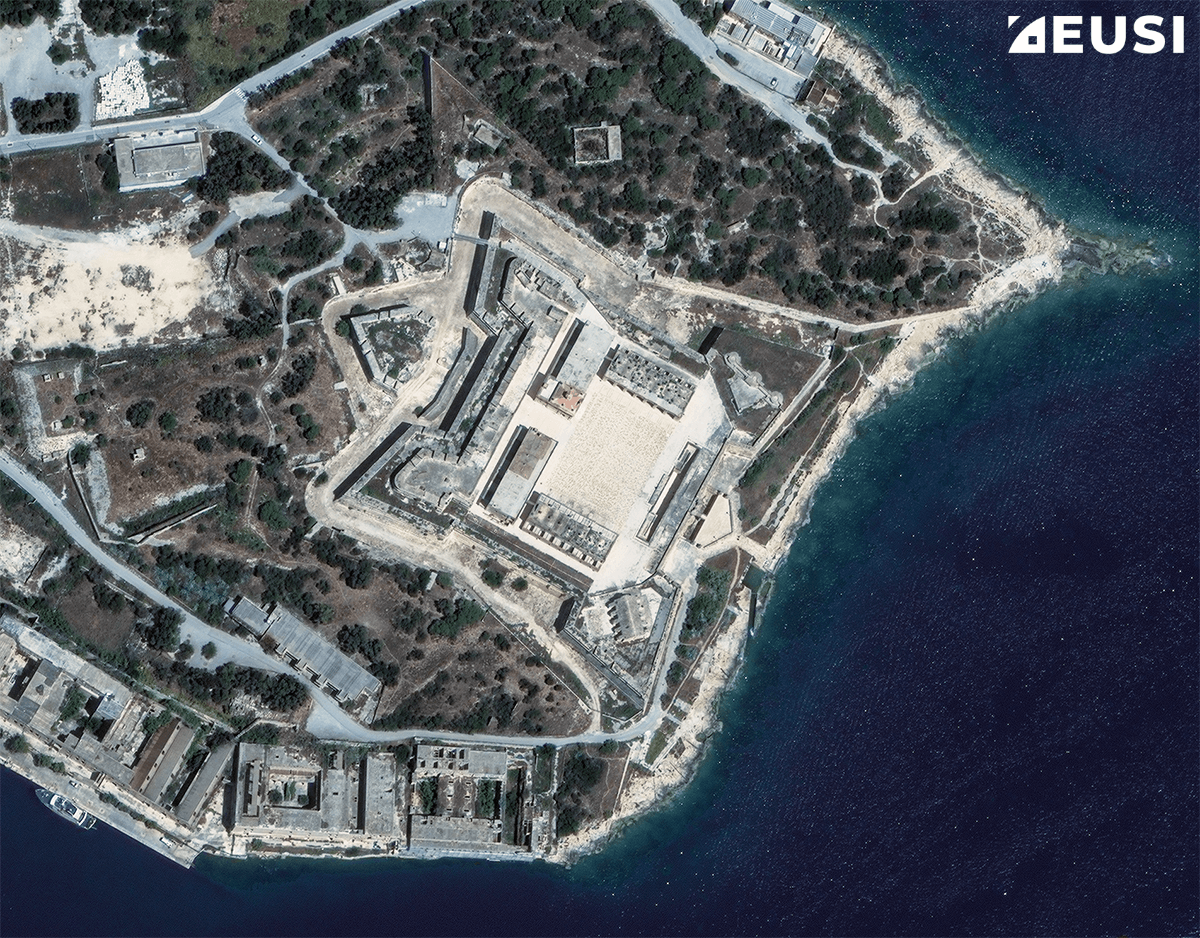
Collected on 6 May 2023 by WorldView-3 satellite at 30 cm resolution. Off-nadir angle: 16.6°. © Maxar Technologies Collected by EUSI
Fort Manoel, a perfect example of maritime defense, is a coastal fortress overlooking the Mediterranean Sea. The star shape is a result of a square-shaped fortification with a pentagonal bastion in each corner. The gate is located between the two bastions facing the sea, and is protected by a lunette – the triangular structure you can see approximately in the middle of the wall. The landward side of the fort is protected by a rock-hewn ravelin. Inside the fortification, you can see a square with several buildings, including an armoury and the barracks.
Fort Manoel, built in the 18th century and considered to be one of the best fortifications, has faced several attacks. It was taken over by the French during the French invasion of Malta (1798), and was declared British property when Malta became a British protectorate (1800). The fort was used in World War II as well, and was eventually decommissioned in 1964.
15. Daugavpils Fortress, Latvia
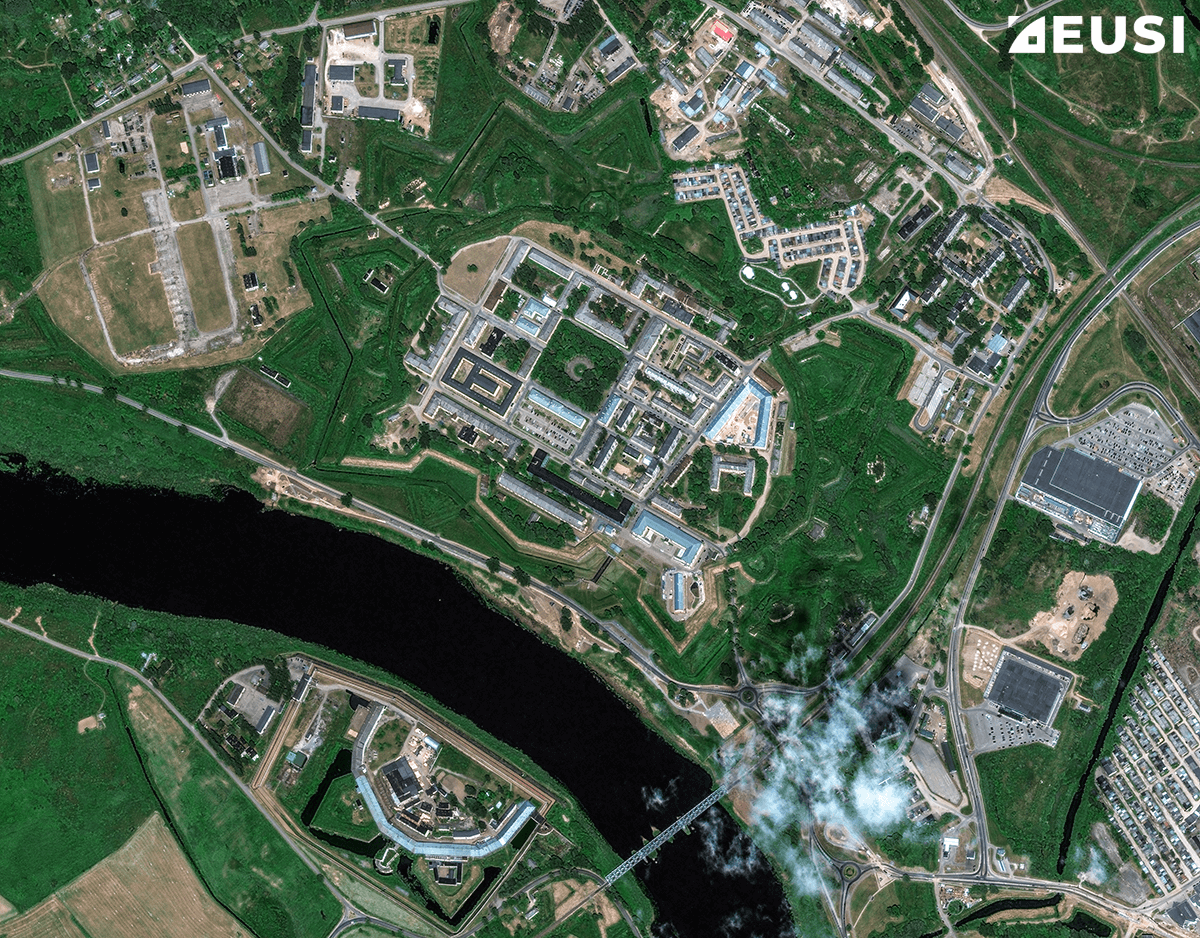
Collected on 20 June 2021 by GeoEye-1 satellite at 50 cm resolution. Off-nadir angle: 29.0°. © Maxar Technologies Collected by EUSI
Nestled alongside the Daugava River in southeastern Latvia, Daugavpils is considered the last bastion fort in the world preserved without any significant alterations since the early 19th century. It is planned as a traditional military town, with 10 wide streets and 80 buildings – residential, as well as administrative and military. There is a parade ground in the center. The main part of the fortification is the citadel, with a complex defense system made around it. The main rampart is over 3 kilometers long, 10 meters high, and 20 meters thick.
The construction of Daugavpils Fort started in 1810 under the orders of Tsar Alexander I of Russia in reaction to the tension caused by Napoleon, and for a long time, it played a role as a defense base of the western border of Russia. Moreover, the road from Europe to St. Petersburg, then capital of the Russian Empire, led through the city of Daugavpils. The fortress was therefore visited by many nobles, including several Russian tsars.
16. Petrovaradin, Serbia
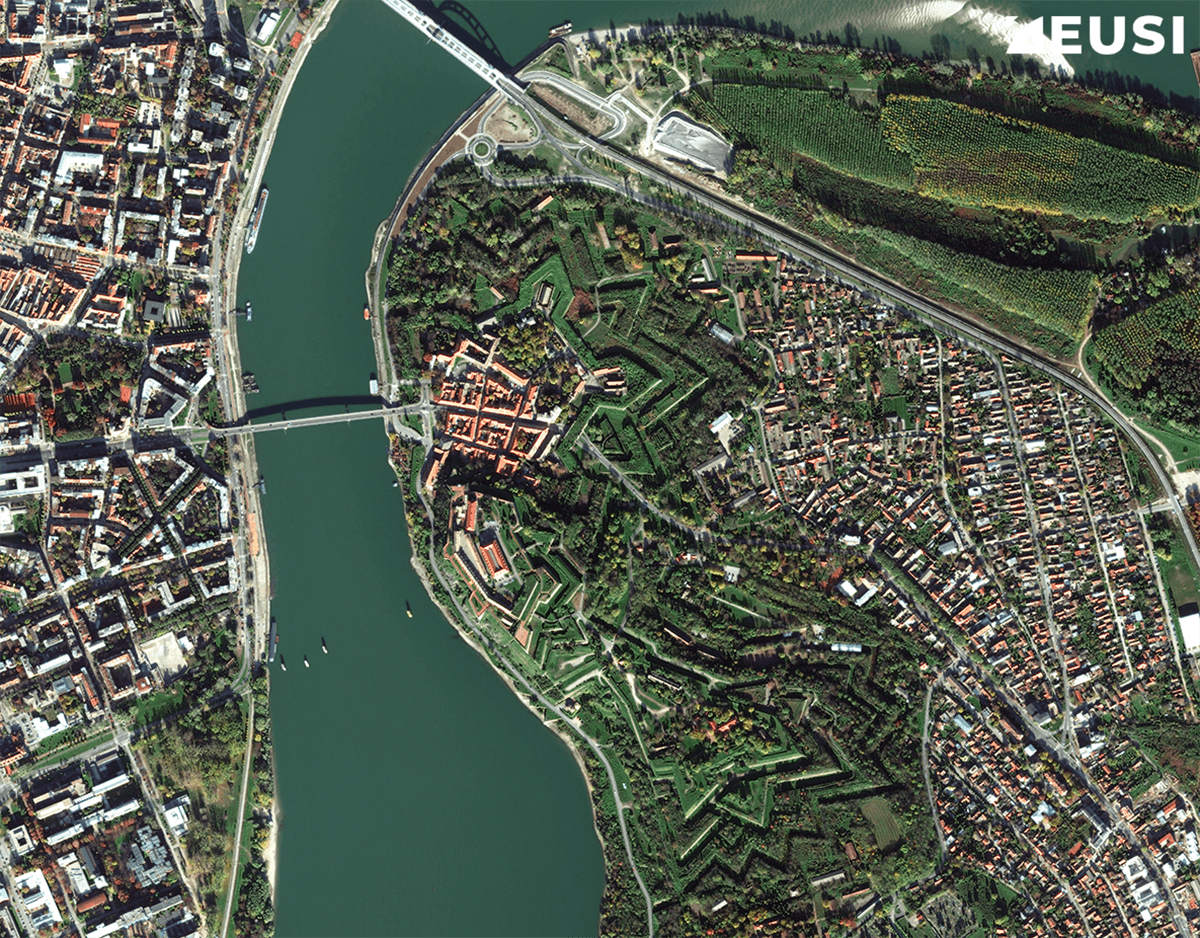
Collected on 13 November 2022 by GeoEye-1 satellite at 40 cm resolution. Off-nadir angle: 12.2°. © Maxar Technologies Collected by EUSI
Nicknamed Gibraltar on the Danube, Petrovaradin Fortress is part of the city of Novi Sad in Serbia. It is divided into Upper and Lower Towns, the Upper Town serving primarily defensive functions, and the Lower Town dedicated to civilian activities. Sixteen kilometers of uncollapsed underground countermine system lie under the fort.
The fortress was constructed in the late 17th century under the Habsburg Monarchy to defend their northern and eastern borders against the Ottoman Empire, and secure control over the Danube. The Ottomans laid siege to Petrovaradin in 1694 but abandoned it not even a month later, as they encountered many logistical and military challenges and were not able to capture the fort.
17. Landskrona Citadel, Sweden
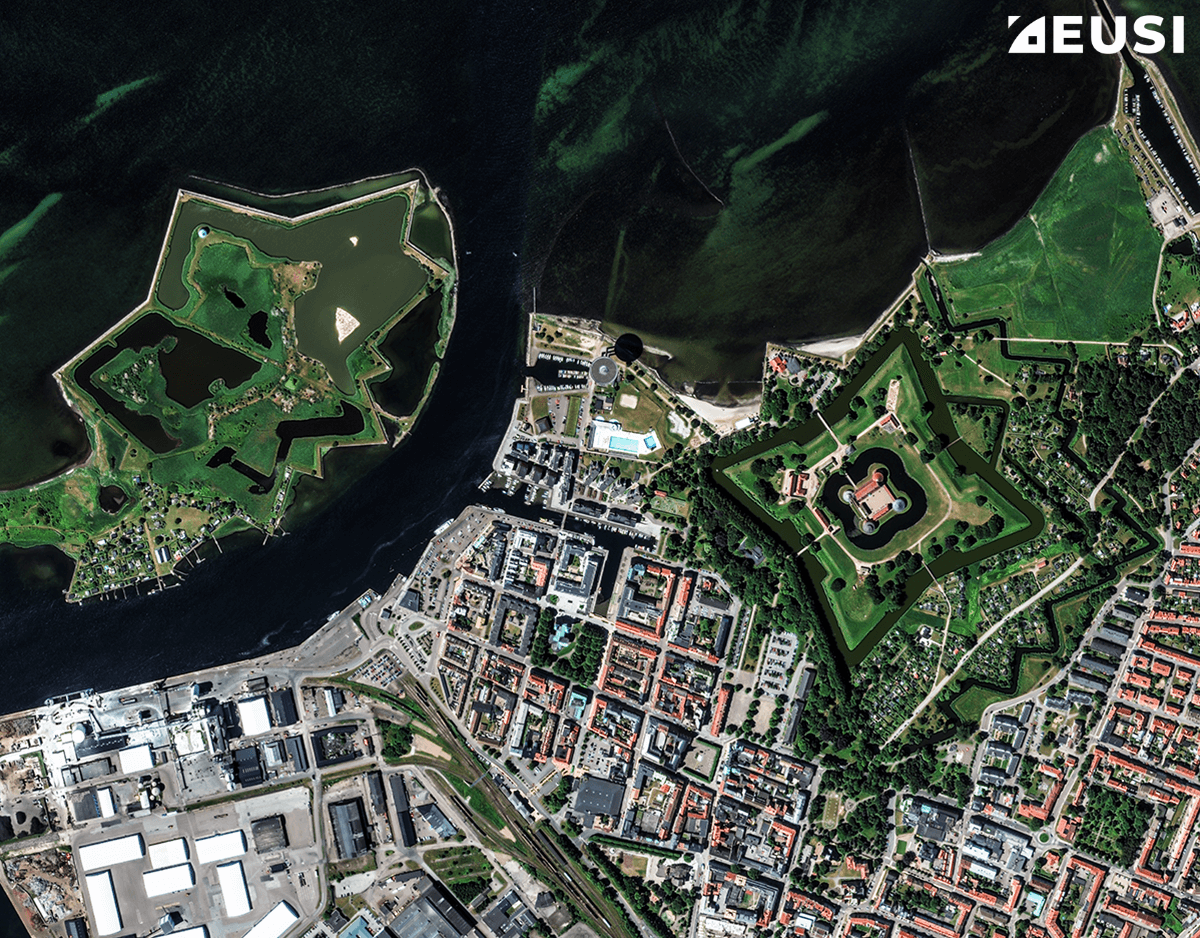
Collected on 28 June 2022 by WorldView-3 satellite at 30 cm resolution. Off-nadir angle: 26.0°. © Maxar Technologies Collected by EUSI
Landskrona Citadel is seamlessly integrated into the urban landscape of Landskrona. It follows the general star fort design but showcases a degree of asymmetry at the same time, as a response to the surroundings. It incorporates features such as a series of moats, a dungeon, and Sweden’s oldest allotment garden.
The Landskrona Citadel was built in the late 16th and early 17th centuries under the orders of King Christian III of Denmark. The primary purpose of its construction was to serve as a defensive fortress guarding the southern approaches to the strategically important Oresund Strait, which was a vital waterway for maritime trade between the Baltic and North Seas. The construction of the Citadel was part of a broader effort to fortify key locations along the Oresund to protect Danish interests and maintain control over toll collection from passing ships.
18. Srebrna Gora, Poland
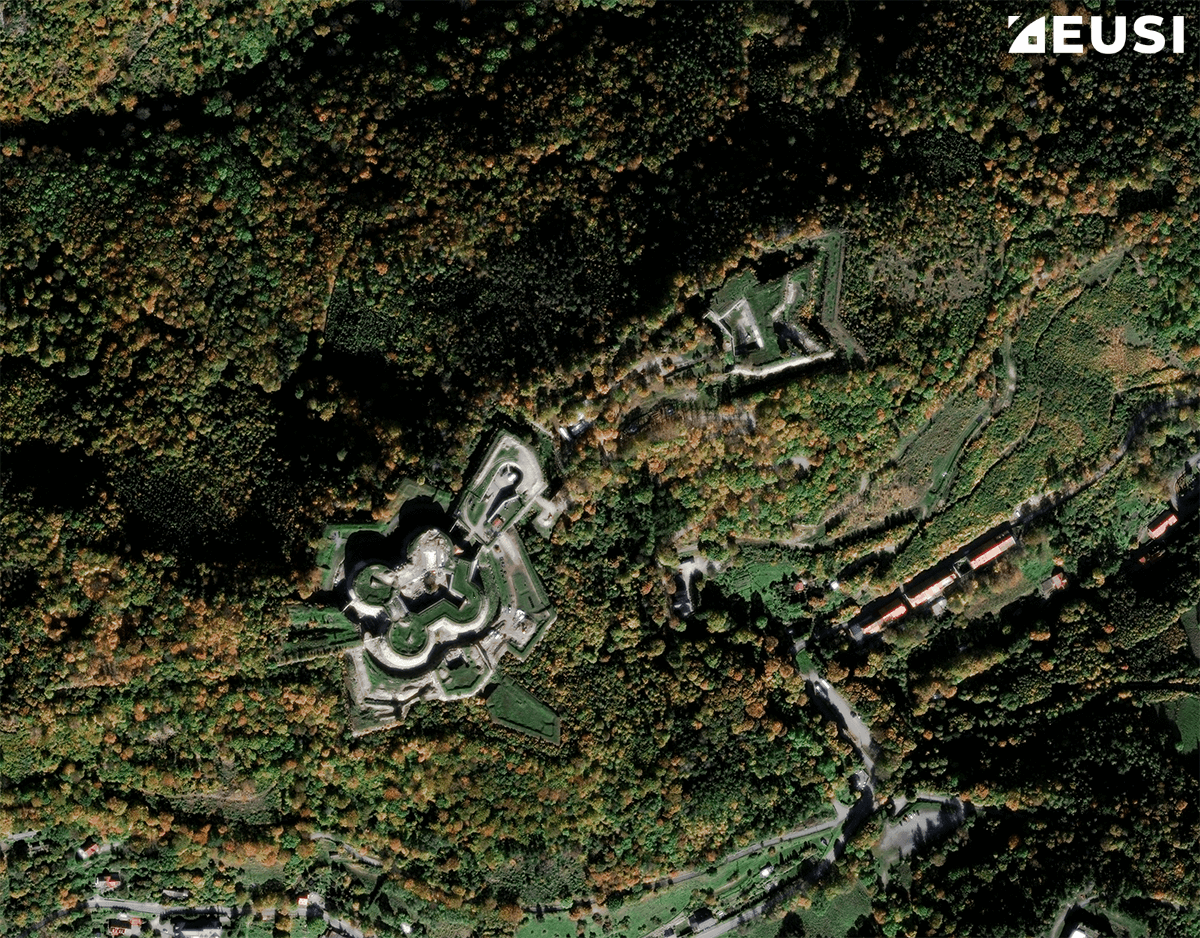
Collected on 12 October 2022 by GeoEye-1 satellite at 40 cm resolution. Off-nadir angle: 7.6°. © Maxar Technologies Collected by EUSI
Srebrna Gora, or Silver Mountain, was originally a settlement near silver ore mines in southwestern Poland. However, the mines were abandoned and when the Prussians captured the region, they transformed the settlement into a series of fortifications able to hold 35,000 men who could withstand a three-month siege.
The entire complex was connected with tunnels, and consisted of several forts: Fort Donjon (in the image), Fort Wysoka Skala, Fort Rogowy, Fort Chochol Maly, and Fort Ostrog. The Donjon Fort included 151 casemates – fortified structures for shooting –, a chapel, a hospital, a brewery, and other buildings.
19. Suomenlinna, Finland
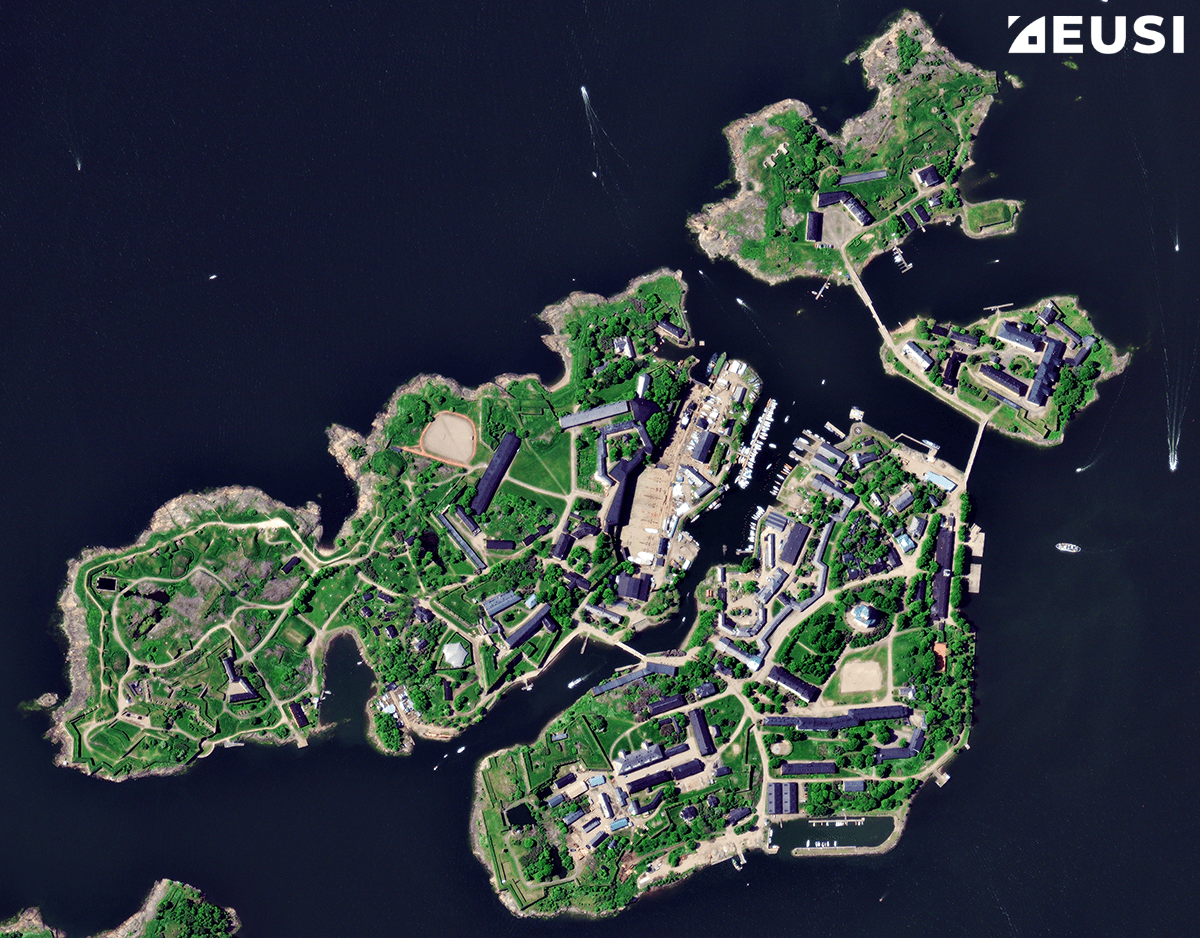
Collected on 2 June 2013 by WorldView-2 satellite at 40 cm resolution. Off-nadir angle: 13.4°. © Maxar Technologies Collected by EUSI
Suomenlinna Fortress, inscribed on the UNESCO Heritage List, spreads across six interconnected islands and showcases the synergy between military architecture and the surrounding seascape. The fort includes 6 kilometers of defensive walls, and 200 buildings including bastions, sandbanks, and barracks. Thanks to its strategic position, Suomenlinna serves as a guardian of the entrance to Helsinki’s harbour.
Its construction began in the mid-18th century during Swedish rule and continued under Russian influence. The design encompassed two primary elements: a network of independent fortifications on the islands and, in the middle of the complex, a navy dockyard. In addition to the island fortress, there are mainland fortifications facing the sea, strategically positioned to prevent an enemy from establishing beachheads for potential attacks on the sea fort.
20. Naarden vesting, the Netherlands
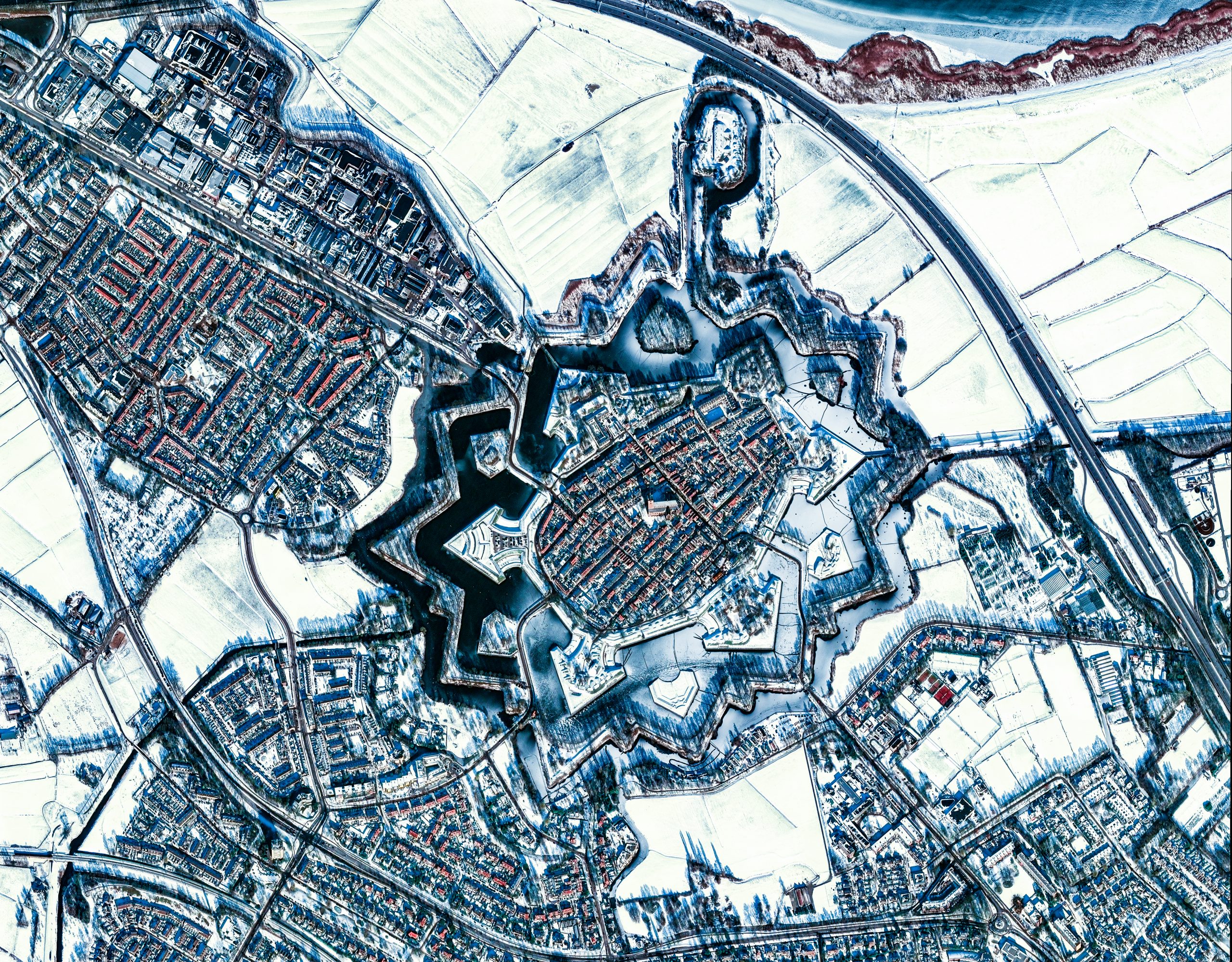
Collected on 13 February 2021 by WorldView-2 satellite at 50 cm resolution. Off-nadir angle: 26.3°. © Maxar Technologies Collected by EUSI
Nestled in the
heart of the Netherlands, Naarden Vesting is one of the best preserved
fortified towns in Europe. Its unique design consists of a series of arrow-headed
bastions connected by double walls, a network of moats, tunnels, and gate
buildings.
Naarden, which was granted city rights in 1351, was turned into a military fortress in the 16th century and got its distinctive star shape in the 17th century. It has witnessed several sieges, including one that lasted for months. Following the capture of Napoleon, Naarden was sieged from November 1813 to May 1814 by a Dutch and Russian army as part of the liberation of the Netherlands.
But that wasn’t the only time it played a role in a war. Thanks to its star shape visible from the sky, Naarden Vesting served as a rallying point for Allied bombers coming back to England after raids on Germany.
Gallery
Related Stories

GEOSeries: Extracting Insights From High Resolution SAR Imagery for Time-Sensitive Analysis
In this webinar, industry experts and advanced users of Umbra SAR data showcase how they transform SAR imagery into actionable insights in real-world mapping, monitoring and intelligence applications. See how NV5 and Umbra leverage ENVI SAR Essentials for advanced processing with time-efficient results, converting analytics into valuable intelligence.

Using Satellite Imagery to Build Water Resilience Across Europe
Water across Europe is facing severe pressure. Climate change, urbanisation, agricultural demands and other sources of pollution are threatening water security and creating critical challenges that need to be addressed. We have to act quickly, build stronger systems and create sustainable water resilience practices – so that both natural ecosystems and human communities can thrive. Here is how satellite imagery from EUSI can help.

EUSI and Albedo Partner to Deliver 10 cm Resolution Satellite Imagery to Europe
It is our pleasure to announce the partnership with Albedo, a builder of high-performance spacecraft and the first satellite designed to operate commercially in VLEO (Very Low Earth Orbit). This partnership will bring the world’s highest resolution satellite imagery to the European and North African market.

Updating the Land Parcel Identification Systems in 2025: The Benefits of Using Satellite Images
Agricultural paying agencies across Europe face increasing challenges in maintaining accurate and up-to-date Land Parcel Identification Systems (LPIS), ensuring compliance with the Common Agricultural Policy (CAP) and supporting sustainable agricultural practices.





